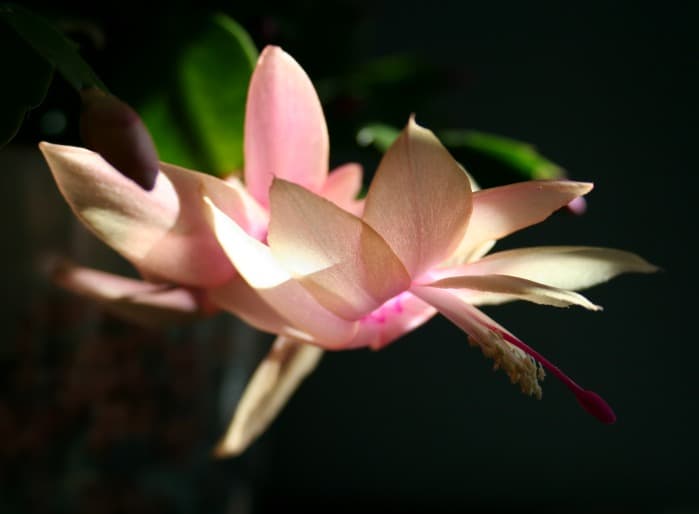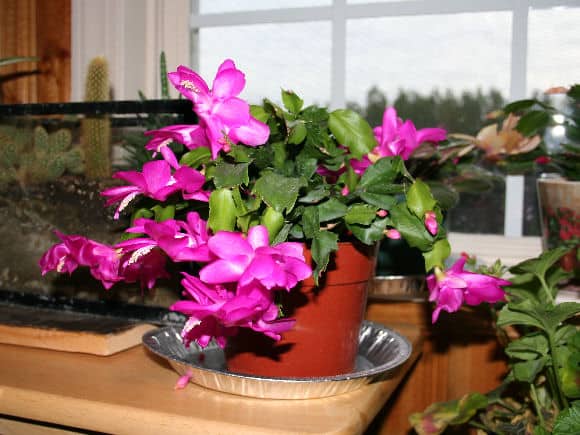With the right conditions, Christmas cactus can live decades. Learn all about Christmas cactus care.

How to Get Your Christmas Cactus to Bloom
Christmas Cactus Care
Christmas cactus care starts by understand the conditions the plants face in the wild. The plants most people call cactus grow in desert areas and are known for their thick fleshy out covering and spines to ward off hungry and thirsty predators. Christmas cactus actually come from the tropical rain forest areas of Brazil, from dense, moist, cool jungle areas about 1,000 feet above sea level.
Think about the differences for a minute. Christmas cactus are actually a tropical cacti that need moist, humid, cool conditions and gentle, filtered light. Typical desert cacti require bright sunshine and hot, dry conditions. If you keep this in mind, caring for Christmas cactus is easier, since you’ll intuitively understand what your plant needs to stay healthy and bloom abundantly this holiday season.
Guidelines for Caring for Christmas Cactus
General guidelines for caring for Christmas cactus include:
- Light – keep your Christmas cactus on a bright, sunny windowsill. A southern or eastern windowsill is best. Since most people purchase Christmas cactus or receive them as a gift around the holidays, keep it indoors. You can bring it outside during the summer months as you would other houseplants but they cannot survive outdoors in the winter in most gardening zones in the United States, with some exceptions.
- Humidity – remember that they come from the tropical rainforests of South America. Consequently, they like high humidity. Most homes during the wintertime have low humidity. To keep your plant happy and keep it from dropping its buds or blooms, place a tray of pebbles under the pot and fill it with water. The evaporating water will keep humidity levels higher around the plant. You can also use misters or sprays of water. Humidity levels should be near 60% for Christmas cactus.
- Water – These plants like evenly moist soil, but don’t soak your plant nor let it get bone dry. Gentle, frequently watering is best. To determine if your plant needs water, stick your finger in the pot and go by how the soil feels. If it clings to your finger, the plant probably doesn’t need water. If it feels dry, give your plant a drink.
- Fertilizer – wait until it has bloomed and fertilize the plant after it has finished blooming. Use a houseplant fertilizer intended for blooming houseplants and use it according to the package directions.
Encouraging New Blooms
By far the most common question plant lovers ask about caring for Christmas cactus is, “How do I get my Christmas cactus to bloom?” Changes in light and temperature trigger the plant’s blooming cycle. Christmas cactus set buds when the temperatures drop into the 60s and even upper 50s, and when the daylight hours grow shorter. Purdue University’s Horticultural Extension Office suggests moving your plant into a dark closet from 8 pm to 8 am daily starting in late October to it set buds. Of course, you’ve got to remember to take it out of the closet each day or else it will die!

Dropping Buds
You may choose a plant that looks beautiful at the greenhouse or store. It’s dark green and filled with buds or flowers. You take it home, put it in a bright, sunny area, and a few days later walk into the room to find the buds or flowers on the table. What happened?
Several factors may cause your plant to lose its buds or flowers:
- Humidity: Greenhouses are kept nice and moist, yet most homes during the wintertime have humidity levels under 20%. That drastic change in humidity may shock your plant into dropping its buds.
- Temperature: The same thing can happen with drastic temperature changes. Greenhouses are kept a constant 70-80 degrees in the wintertime, yet the temperature on a windowsill with a draft can plunge. Check the temperature near your plants. They like it cool, but not cold.
- Water: Don’t let your it go for long periods of time without watering it. If you have forgotten to water it, give it a gentle drink rather than a good soaking. Christmas cactus prefer light, frequent waterings rather than infrequent heavy waterings.
Keep Them as House Plants
You can enjoy your Christmas cactus as a houseplant year-round. Flower colors include white, pink, magenta, red and peach colors, and they are easily propagated by taking a cutting and using some root hormone and potting soil. New plants should be the same color as the parent plants, but may sometimes be white, indicating a reversal to the original genetic material.




